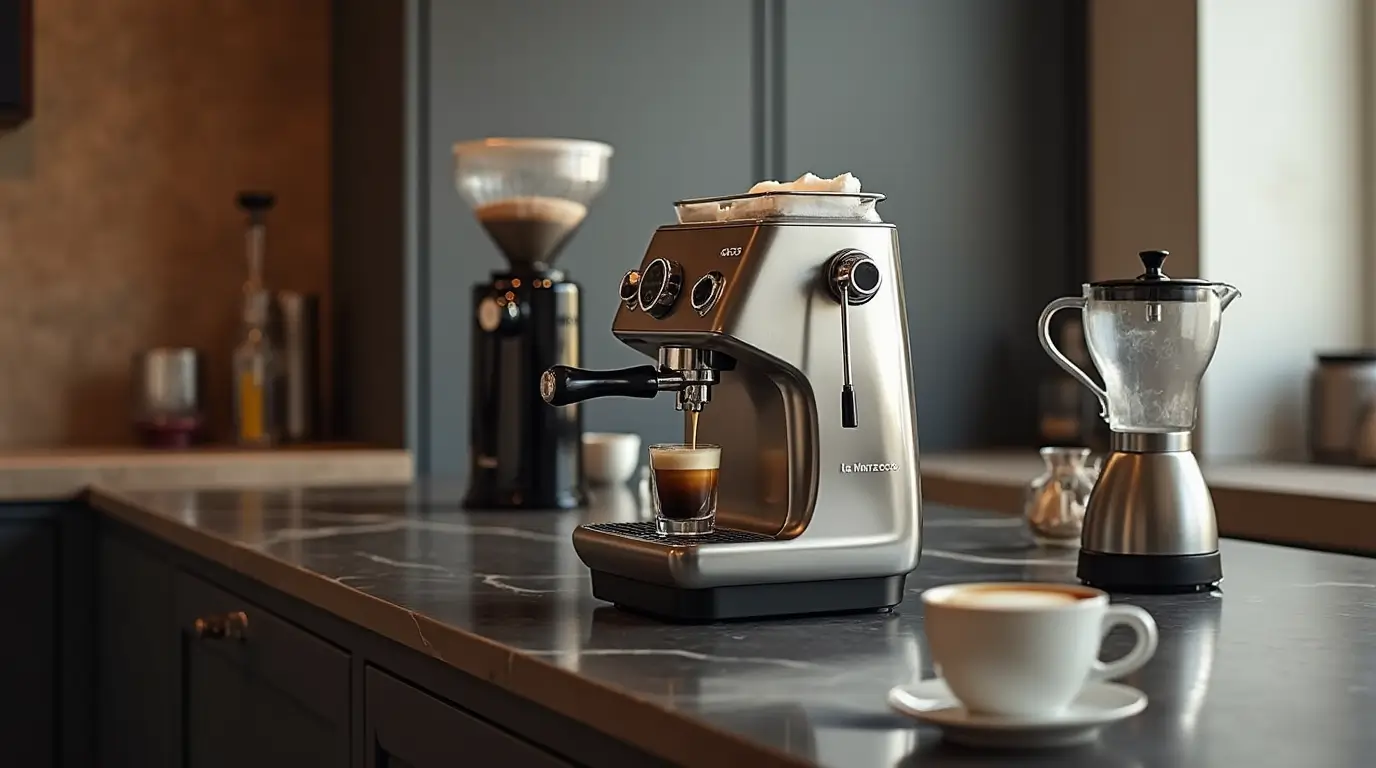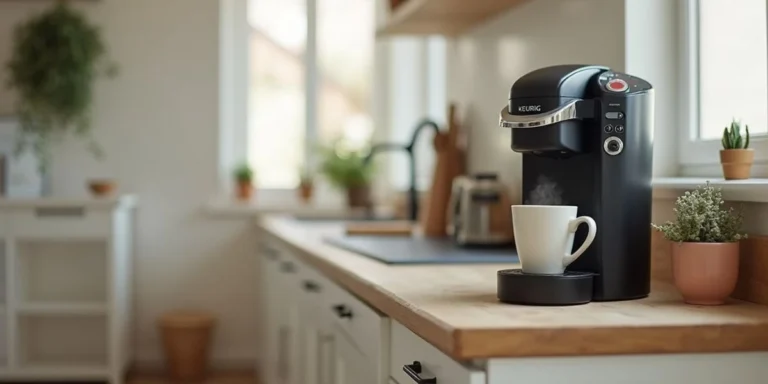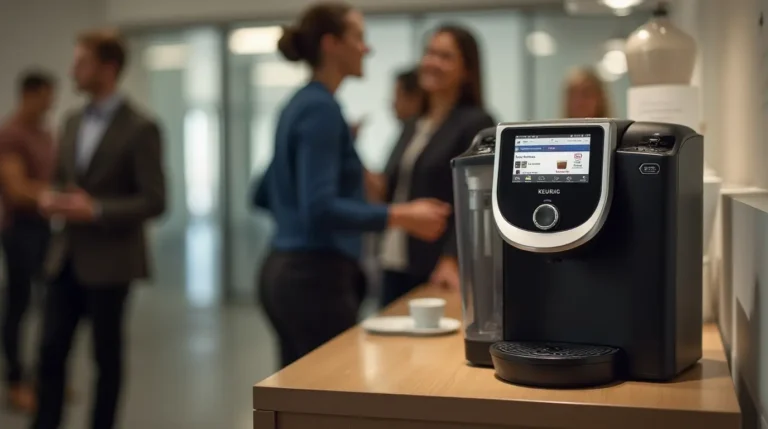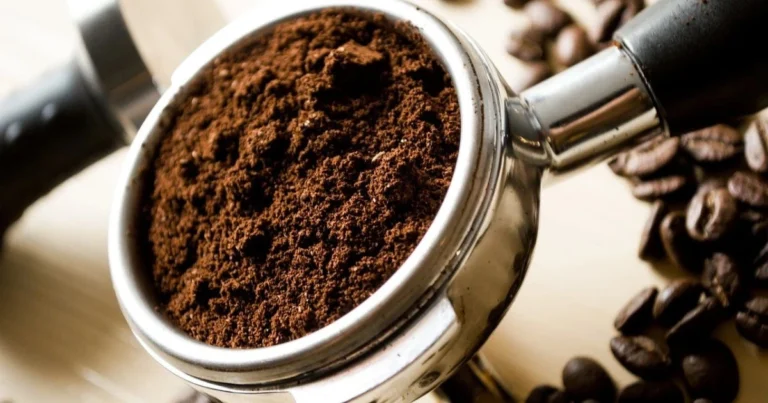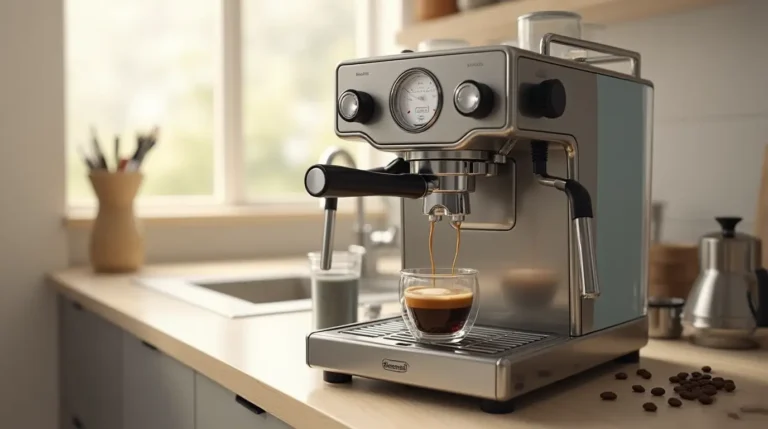How to Get the Best Out of Your La Marzocco Espresso Machine
When it comes to premium espresso machines, the La Marzocco espresso machine stands in a league of its own. Trusted by professional baristas and coffee enthusiasts around the world, La Marzocco machines are known for their exceptional build quality, cutting-edge features, and the ability to deliver café-quality espresso right at home. Whether you own the compact Linea Mini, the versatile GS3, or another model in their iconic lineup, getting the most out of your investment requires more than just turning it on and pulling a shot.
In this guide, we’ll show you how to unlock the full potential of your La Marzocco espresso machine—from dialing in the perfect grind to mastering milk steaming, and keeping your machine in peak condition. Whether you’re a seasoned home barista or just getting started, these tips will help you elevate every espresso experience.

Setting Up Your La Marzocco Espresso Machine for Optimal Performance
Getting your La Marzocco espresso machine ready is a critical step in achieving high-quality, consistent espresso at home. From placement and power to choosing the right grinder, every decision affects your brewing experience.
Unboxing and Initial Setup
Once your machine arrives:
- Carefully unpack and inspect all components.
- Verify the presence of essential parts such as the portafilter, drip tray, power cable, and user manual.
- Position the machine on a sturdy, level surface with easy access to the water tank or plumbing port.
Choosing the Right Location and Power Setup
Stable Countertop
- Use a surface that supports the machine’s weight (some models exceed 70 lbs).
- Ensure your setup area is near your sink or water supply if you plan to plumb the machine.
Voltage Requirements
- Most La Marzocco home machines run on 120V (in North America).
- Plug directly into a grounded wall outlet—avoid using extension cords or power strips.
Water Source: Reservoir vs. Plumbed-In
| Water Source | Advantages | Considerations |
|---|---|---|
| Reservoir | Portable, no plumbing required | Must refill regularly, less suited for high use |
| Plumbed-In | Unlimited water access, efficient | Requires installation, water line, and filter |
Tip: Always use filtered water to reduce scale buildup and enhance flavor.
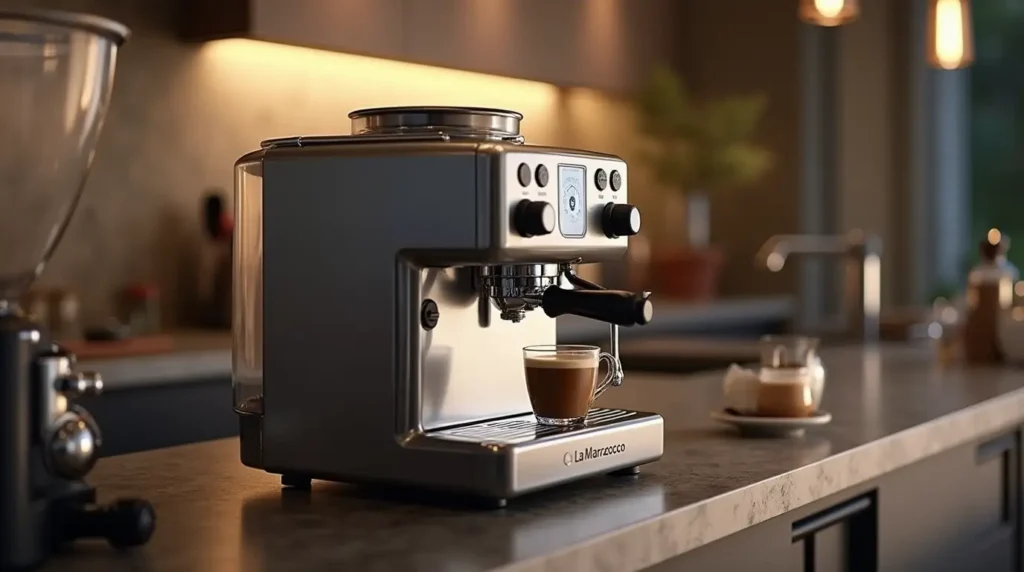
Understanding the Dual Boiler System
La Marzocco machines come equipped with a dual boiler system—one for brewing and one for steaming.
Key Benefits
- Simultaneous Brewing and Steaming: Perfect for making milk-based drinks quickly.
- Temperature Stability: Each boiler is PID-controlled for consistent, repeatable results.
- Workflow Efficiency: No need to wait between pulling shots and frothing milk.
This setup mimics commercial café environments, making it ideal for serious home baristas.
Recommended Grinder Pairings
Pairing your La Marzocco with the right grinder is essential for achieving optimal extraction and flavor. Here are some top options known for their build quality and precision:
| Grinder Model | Burr Type | Ideal For |
|---|---|---|
| Mazzer Mini | Flat Burr | Linea Mini, GS3 |
| Eureka Mignon Specialita | Flat Burr | Linea Mini |
| Baratza Sette 270Wi | Conical Burr | Entry-level home use |
| Niche Zero | Conical Burr | All La Marzocco models |
| Mahlkönig X54 | Flat Burr | High-end home setups |
What to Look for in a Grinder
- Stepless adjustment for fine-tuning grind size
- Low retention for better dose consistency
- Consistent particle distribution for improved flavor and crema
Your grinder’s performance directly influences shot quality—so it’s worth investing in one that matches your machine’s capabilities.
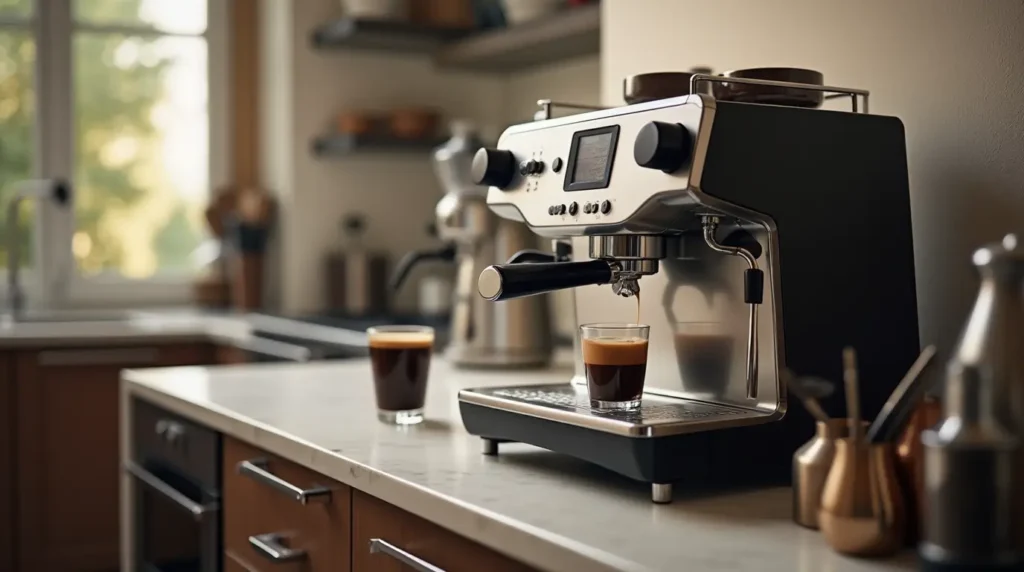
Dialing In the Perfect Espresso Shot
Making espresso isn’t just about pushing a button—it’s an art form that combines precision, practice, and patience. Even with a powerful machine like a La Marzocco, dialing in your espresso is essential to getting rich crema, balanced flavor, and that signature café-quality shot.
Importance of Grind Size and Dose
Grind Size
- Espresso requires an extremely fine grind, similar to powdered sugar.
- Too coarse = under-extracted (sour, watery)
- Too fine = over-extracted (bitter, harsh)
Use a stepless grinder for micro-adjustments and dial in slowly. Small changes can make a big difference.
Dose Consistency
- Use a precision scale to weigh your coffee dose—typically between 17g–20g for a double shot.
- Stick to consistent dosing every time. Even a 0.5g variance can impact flavor and shot time.
Puck Preparation
- Distribute the grounds evenly before tamping to avoid channeling.
- Use a distribution tool or simply tap the portafilter gently to level the coffee bed.
- Apply a firm, level tamp using 30–40 lbs of pressure. Consistency is more important than strength.
Optimal Brew Ratio and Extraction Time
Understanding Brew Ratio
A standard starting point is a 1:2 ratio—meaning for every 18g of coffee in, you should yield 36g of espresso out.
| Dose In (g) | Yield Out (g) | Ratio |
|---|---|---|
| 18g | 36g | 1:2 |
| 20g | 40g | 1:2 |
This ratio helps ensure the espresso is strong but not overly concentrated.
Timing Your Shots
- Use a shot timer or built-in timer on your La Marzocco.
- Aim for a total extraction time of 25–30 seconds for a double shot.
- If your shot is too fast or too slow, adjust the grind size, dose, or tamping pressure accordingly.
Adjusting Temperature with the PID Controller
La Marzocco machines feature a PID (Proportional-Integral-Derivative) controller, which allows you to precisely manage water temperature—key to unlocking flavor nuances.
What is PID?
A PID system maintains stable boiler temperatures by making real-time adjustments, which helps avoid temperature fluctuations during brewing.
Ideal Brewing Temperatures
- The sweet spot is typically between 195°F and 205°F.
- Lower temperatures highlight acidity and fruitiness.
- Higher temperatures bring out bitterness and chocolate notes.
Start at 200°F and adjust in small increments based on your beans and flavor preference.
Common Espresso Shot Issues and How to Fix Them
Here are the most frequent problems people face when pulling espresso shots, and how to troubleshoot them:
1. Over-Extraction
- Symptoms: Bitter, dry, harsh taste
- Causes: Grind too fine, brew time too long, dose too high
- Fixes: Coarsen grind, reduce extraction time, lower dose
2. Under-Extraction
- Symptoms: Sour, thin, salty taste
- Causes: Grind too coarse, short brew time, dose too low
- Fixes: Finer grind, increase brew time, adjust dose up
3. Channeling
- Symptoms: Inconsistent flow, weak or uneven shot
- Causes: Uneven tamping, poor distribution, clumps in grounds
- Fixes: Use a distribution tool, level tamp, break up clumps
Steaming Milk Like a Pro with La Marzocco
The ability to create silky, velvety milk is what separates a decent cup of coffee from a café-quality latte or cappuccino. La Marzocco machines are known for their powerful steam wands, giving you the tools to master milk steaming at home. Whether you’re aiming for perfect microfoam or smooth, creamy milk, this guide will show you how to get there.
Understanding Steam Pressure and Wand Position
La Marzocco machines deliver commercial-grade steam pressure, which means milk will heat and froth quickly. But to control texture and consistency, proper technique is key.
Wand Position and Pitcher Placement
- Angle: Insert the steam wand at a slight angle (around 10–15 degrees) so the milk swirls in a vortex. This helps evenly distribute heat and breaks up bubbles.
- Depth: Start with the wand just below the surface of the milk. This introduces air (stretching phase). Then, lower the pitcher slightly as the milk expands.
- After Stretching: Submerge the wand deeper to heat the milk and incorporate the foam (texturing phase).
Steaming for Different Drinks
- Cappuccino: Requires more air, resulting in a denser foam layer.
- Latte: Needs a smoother, creamier texture with moderate foam.
- Flat White: Features a very thin microfoam with minimal air incorporation.
Milk Texture Guide
Use this quick reference table to aim for the right milk temperature and froth consistency depending on the drink you’re making:
| Drink Type | Milk Temp | Texture | Froth Level |
|---|---|---|---|
| Cappuccino | 140°F (60°C) | Velvety Microfoam | High |
| Latte | 150°F (65°C) | Creamy | Moderate |
| Flat White | 130°F (55°C) | Silky Smooth | Low |
Tip: Use a milk thermometer or your hand as a guide. The milk should feel hot to the touch (but not painful) just as it reaches 130°F–150°F.
Common Steaming Mistakes to Avoid
Even with the right machine, small errors can ruin the milk’s texture and taste. Avoid these common mistakes:
- Scalding the Milk: Overheating milk beyond 160°F breaks down proteins, causing a burnt taste and grainy texture.
- Introducing Too Much Air: Keeping the wand too close to the surface for too long creates large bubbles and dry froth instead of microfoam.
- Not Purging the Wand: Always purge before and after steaming to remove condensation and avoid introducing water into your milk.
Tips for Latte Art Practice
Once you’ve nailed the milk texture, latte art is the next step in your home barista journey. Start simple and build your technique over time.
1. Use Whole Milk
Whole milk is ideal for latte art due to its higher fat content, which helps create a more stable and glossy microfoam.
2. Practice with a Heart Pattern
- Begin with a simple heart shape—it’s the easiest design and builds the core pouring skills you’ll need for rosettas and tulips later.
- Hold the cup at a slight angle and start pouring slowly, then increase flow as you bring the pitcher closer to the surface.
3. Steam in Small Batches
Use around 5–6 oz of milk per drink. Smaller batches are easier to control and ideal for practicing without wasting ingredients.
4. Use a Proper Milk Pitcher
Choose a 12 oz or 20 oz stainless steel milk pitcher with a narrow spout for better control during pouring.
Maintenance Tips to Keep Your Machine in Top Shape
Your La Marzocco espresso machine is a precision-crafted powerhouse—but like any high-end tool, it needs regular care to stay in peak condition. Routine maintenance not only ensures consistently delicious espresso but also extends the life of your machine and reduces the risk of costly repairs.
Let’s walk through daily, weekly, and monthly maintenance tasks, along with essential cleaning and water care tips.
Daily, Weekly, and Monthly Maintenance Checklist
Here’s a simple, practical breakdown of what to do and when:
Daily Maintenance
- Wipe down the steam wand and purge it after each use.
- Rinse and wipe the portafilter and basket after every shot.
- Run clean water through the grouphead after each use.
- Empty and clean the drip tray and water reservoir (if applicable).
Weekly Maintenance
- Perform a backflush with espresso machine cleaner (see below).
- Soak the portafilter and baskets in a solution of hot water and espresso cleaner.
- Clean the steam wand tip with a pin or paperclip if clogged.
- Wipe the grouphead screen and gasket with a soft brush or towel.
Monthly Maintenance
- Inspect and replace water filters as needed.
- Perform a deep clean of your grinder and check for coffee oil buildup.
- Check all seals, screens, and hoses for wear or leaks.
- Begin monitoring for signs of scale buildup (e.g., slow heating or changes in shot quality).
Cleaning the Grouphead and Portafilter
The grouphead and portafilter are where all the action happens—so keeping them clean is essential.
Why Backflushing Matters
Backflushing cleans out coffee oils and fine grounds that accumulate in the grouphead valve and solenoid system.
How to Backflush (For Machines with a 3-Way Solenoid Valve)
- Insert a blind filter basket into your portafilter.
- Add a small amount of espresso machine cleaner (like Cafiza).
- Lock the portafilter into the grouphead.
- Run the pump for 10 seconds, then stop. Repeat several times.
- Rinse thoroughly by repeating the process using only water.
Note: Not all La Marzocco home models (like the Linea Mini) are designed for traditional backflushing. Consult your manual.
Descaling the Boiler System
Mineral deposits from hard water can build up inside your boiler and affect heating, pressure, and overall performance.
When to Descale
- Typically every 3–6 months, depending on water hardness and machine use.
- More frequently if you notice reduced steam pressure or slow heat-up times.
How to Descale
- Use a manufacturer-approved descaling solution.
- Follow La Marzocco’s descaling procedure (available in your manual).
- After descaling, flush the system thoroughly with clean water to avoid affecting taste or damaging internal parts.
Caution: Some La Marzocco models are sensitive to descaling chemicals—check your machine’s manual before performing any internal cleaning.
Changing Water Filters and Monitoring Water Quality
Using clean, properly filtered water is one of the most important things you can do for your espresso machine.
Why It Matters
- Poor water quality leads to scale buildup, corrosion, and poor coffee flavor.
- Many performance issues in espresso machines are directly tied to water chemistry.
Best Practices
- Use a charcoal or resin water filter in your reservoir or install an inline filtration system if plumbed in.
- Change filters every 2–3 months, or as specified by the manufacturer.
- Test your water regularly for hardness—ideal hardness is around 50–70 ppm (parts per million).
- Avoid distilled water (too pure) or unfiltered tap water (too hard or chlorinated).
Pro Tips for Longevity
- Log your cleaning schedule to stay consistent.
- Keep a spare set of gaskets, grouphead screens, and a backup water filter on hand.
- If your machine has a PID controller, make sure the firmware is updated and temperature settings haven’t drifted.
FAQ Section
Adding a Frequently Asked Questions section is a great way to address common concerns that users may have—and it can increase your chances of getting your content featured in Google’s “People Also Ask” section.
Here are a few FAQ entries you can include:
How long does a La Marzocco espresso machine last?
La Marzocco espresso machines are known for their exceptional build quality and can easily last 10 to 20 years or more with proper maintenance. Many commercial models are still in operation after decades of use, thanks to their durable components and serviceable design.
Can I use tap water in a La Marzocco machine?
While technically possible, using unfiltered tap water is not recommended. Tap water often contains minerals and chemicals that can lead to scale buildup, corrosion, and taste issues. It’s best to use filtered or softened water to preserve your machine’s lifespan and ensure consistent espresso flavor.
What is the difference between the Linea Mini and GS3?
The Linea Mini is a more compact, home-oriented version of La Marzocco’s commercial lineup. The GS3, on the other hand, offers advanced features like a digital display, programmable settings, and superior temperature stability, making it ideal for serious home baristas or small businesses.
Do I need to backflush the Linea Mini?
The Linea Mini does not have a 3-way solenoid valve, so traditional backflushing with a blind portafilter isn’t required. However, daily rinsing and weekly cleaning of the grouphead, screen, and portafilter are still essential to maintain performance.
Conclusion
Owning a La Marzocco espresso machine is more than just a purchase—it’s a commitment to crafting exceptional coffee at home or in your café. With its professional-grade design, powerful features, and unmatched durability, this machine gives you the tools to brew like a barista.
From setting up your workspace and dialing in the perfect shot to steaming milk like a pro and staying on top of maintenance, each step is part of the rewarding process of espresso mastery. Whether you’re using a Linea Mini or GS3, following the right techniques ensures consistent, high-quality results—and a machine that lasts for years to come.
Ready to elevate your coffee game? Bookmark this guide, practice regularly, and don’t be afraid to experiment. Your perfect cup is just a few tweaks away.

